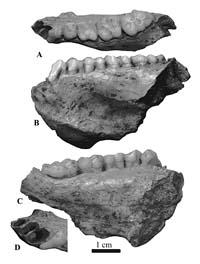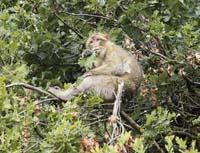A macaque in Lezetxiki

UPV archaeologists discover a monkey over 100,000 years
During sampling to investigate the climate of about 100,000 years ago, the fossil of a jaw has been found in the cave of Lezetxiki in Arrasate. The fossil belongs to the species Macaca sylvanus, similar to the current macaques of Gibraltar. "So far it has never appeared in the north of the Iberian peninsula," says UPV researcher Aritza Villaluenga. "After a long bibliographic search, we discovered that the last vestiges of this [species] appeared in Valencia and Andalusia, and 300,000 years ago."
Fossil is a major contribution to climate research. Lezetxiki's jaw has a maximum age of 120,000 years. "It's something prior to the start of the last glaciation and that's why we thought the weather was cooler than the current one. But the explanation of this maca makes us think it was like the current climate."
The analysis of other remains taken in the same sediment, such as the study of pollen, geology and micromammals, will help confirm this idea. This data will also help in dating. "The rodents (mice) that appear in it are well-known species," says Villaluengak--. Depending on the weather and the time to time they changed very quickly." The macaque jaw was located between the two species of rodents, so researchers know what time it is.
Rare species

Incomplete jaw. It lacks the front and back faces, is the central part and has some tweezers in place. Although not complete, archaeologists soon realized that they had never found such fossils. "It was evident that the bone was not of bears, nor of any of the species we found. We went to the Society of Aranzadi, where they have a collection of bone reference of numerous species, where we find that Macaca is sylvanus".
This discovery has now been published in the Journal of Human Evolution. In addition to research on human fossils, this journal also includes studies related to the evolutionary context of human beings. "Joxe Miel Barandiaran found in Lezetxiki Homo Heilderbergensis in humerus. Their human and macaque groups lived around the same time."
However, UPV researchers do not believe that humans eat macaques. "In the same sampling we find many rodents. This makes us think that some predator would hunt the macaque and give up the bone we have found. Maybe it's a big bird, like an owl," says Villaluenga.





